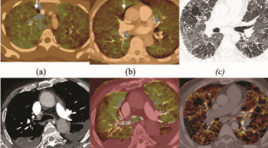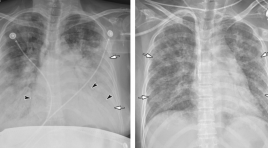
CHỤP CẮT LỚP VI TÍNH HAI MỨC NĂNG LƯỢNG PHÁT HIỆN TẮC ĐM PHỔI: LỢI ÍCH THÊM VÀO CỦA BẢN ĐỒ IODINE
11/10/2023 12:57:49 | 0 binh luận
Summary Purpose: To determine if there is an added benefit of using iodine maps from dual-energy (DECT) in addition to conventional CT angiography images to diagnose pulmonary embolism (PE). Materials and Methods : In this retrospective analysis, 49 consecutive dual-energy CT angiography examinations performed from August through July 2020 at Bach Mai Hospital to evaluate for PE were reviewed. The 49 examinations included 49 patients (mean age, 59.73 years; range, 22–99 years). First, the location, level, and type (occlusive vs nonocclusive) of PEs on conventional CT angiograms were recorded. Iodine maps were then reviewed for defects suggestive of PE. Last, CT angiograms were rereviewed to detect additional PEs suggested by the iodine map. Results: 19/49 (38.8%) patients were diagnosed with PE, a total of 247 PEs were detected at initial review. After review of the DECT iodine map, 16 additional PEs were found on 8 of 49 (16.3%) patients in which 2 of 49 (4 %) patients had a new diagnosis of PE after review of the DECT iodine maps, 4/49 (8%) patients were diagnosed PE before. Of the 16 additional PEs, 8 (50%) were segmental, 8 (50%) were subsegmental, 3 (18.8 %) were occlusive, and 13 (81.2%) were nonocclusive Conclusion: Dual-energy CT iodine maps show a small incremental benefit for the detection of occlusive segmental and subsegmental pulmonary emboli. Keywords: CTPA= computed tomography pulmonary angiography, DECT= dual-energy computed tomography, PE= pulmonary embolism, iodine map.

KHÔNG CÓ ĐỘNG MẠCH PHỔI PHẢI: NHÂN 2 TRƯỜNG HỢP KHÁM VÀ ĐIỀU TRỊ TẠI BỆNH VIỆN PHỔI TRUNG ƯƠNG
15/11/2021 17:40:49 | 0 binh luận
SUMMARY Absence of the right pulmonary artery (RPA) is a rare congenital anomaly, with an estimated prevalence of 1 in 200,000 young adults. The disease may be asymptomatic or may present with nonspecific symptoms such as cough, dyspnea, or chest pain. In children, there may be respiratory failure or high pulmonary hypertension. The disease can be associated with other congenital abnormalities such as ventricular septal defect, atrial septal defect, ductus arteriosus, tetralogy of Fallot... We present 2 cases of RPA examined and treated at the National Lung Hospital for recurrent pneumonia. These two cases did not have a combination of congenital diseases, in which one case had pulmonary hypertension. Both patients received medical treatment and gave good results. Keyword: Isolated absence of right pulmonary artery, Unilateral absent pulmonary artery

Đặc điểm hình ảnh và giá trị cắt lớp vi tính của bất thường nang tuyến phổi bẩm sinh
23/05/2020 12:04:47 | 0 binh luận
Imaging characteristics and the accuracy of computered tomography in predictability of congenital pulmonary airway malformation SUMMARY Perpose: To describe imaging characteristics and to analyse the value of CT-scanner in treatment of congenital pulmonary airway malformation (CPAM). Material and Methods: Retrospective imaging description of chest CT-scanner was done on 61 children patients suspected of CPAM on clinical examination in national chidren Hospital from January 2011 to June 2014. in which 33 cases were diagnosed of CPAM on histopathology. The value of CT-scanner were analysed in diagnosed of CPAM. Results: CPAM is common in right lower lobe. It contains one or multicytic mas (≥ 5 cysts) with cystic wall ≤ 2.5 mm, no private feeding artery. There are statitistically significant different between diameter of largest cysts in each other típ. CPAM is an air cytic (45.6%), air-fluid level cystic (9.1%), fluid cystic mass (27.2%) or complex mass (18.1%). The sensitivity of CT in diagnosis CPAM is 100%, specificity is 75%, and accuracy is 88.5%. Conclusions: CPAM demonstrates a variety of CT appearances based on the type of CPAM. CT has high accuracy in diagnosis CPAM. Keywords: Congenital pulmonary airway malformation (CPAM), computered tomography (CT).

Quan điểm hình ảnh Xquang do Coronavirus 2019 (COVID-19): Bài học từ Hội chứng hô hấp cấp tính nặng và Hội chứng hô hấp vùng Trung Đông
25/03/2020 14:47:42 | 0 binh luận
MỤC TIÊU: Kể từ khi dịch bệnh bùng phát do chủng coronavirus mới 2019 (COVID-19) tại Trung Quốc, đã có hơn 79,000 người đã bị nhiễm trên toàn thế giới. Loại virus này lây lan nhanh chóng từ người sang người mặc dù đã áp dụng các biện pháp ngăn ngừa (số liệu cập nhật đến 7h31 ngày 24/03/2020, tổng số 378.000 người nhiễm và 16.400 người tử vong). Do có những hội chứng phổi tương đồng đã được báo cáo từ chủng coronavirus khác, mục tiêu của chúng tôi là xem xét những bài học từ những nghiên cứu hình ảnh thu được trong Hội chứng hô hấp cấp tính nặng (SARS) và Hội chứng hô hấp vùng Trung Đông (MERS). KẾT LUẬN: Việc xem xét kinh nghiệm từ vụ dịch SARS và MERS sẽ giúp chúng ta hiểu hơn về vai trò của bác sỹ Xquang trong chống lại dịch bệnh COVID-19. Những vấn đề hình ảnh đã biết do coronavirus mới và những những ẩn số cũng có thể sẽ được thảo luận.

Đặc điểm hình ảnh Xquang viêm phổi do CORONA VIRUS
26/02/2020 17:13:00 | 0 binh luận
Chủng corona virus mới 2019 (2019 – nCoV) đang gây dịch viêm đường hô hấp cấp tại Vũ Hán (Trung Quốc) là một chủng mới phát hiện. Tuy nhiên chủng virus này có mối quan hệ mật thiết với chủng virus gây đại dịch SARS (Severe Acute Respiratory Syndrome) năm 2003 và dịch MERS (Middle East Respiratory Syndrome) năm 2012, nằm trong nhóm “bệnh truyền nhiễm mới nổi-Emerging Infectious Diseases (EIDs)” gây ra bởi nhiều nguyên nhân đặc biệt là virus [1].

Sự liên quan giữa viêm phổi do Covid 19 và ARDS
28/02/2020 09:17:28 | 0 binh luận
Trong thời điểm dịch covid 19 phát tán rộng trên toàn thế giới chúng tôi xin giới thiệu đến quý độc giả bài tổng hợp phân tích mối liên quan giữacovid 19 và ARDS. Bài báo cáo có những nội dung sau: Ý nghĩa của các dấu hiệu trên CT viêm phổi Covid-19 ARDS (Hội chứng nguy cấp hô hấp ở người lớn) Sự liên quan giữa viêm phổi covid-19 với ARDS Kết Luận

Khảo sát hệ hô hấp ở trẻ em, hình ảnh bình thường
21/11/2019 14:49:43 | 0 binh luận
Hệ hô hấp bao gồm mũi, hầu họng, thanh quản, khí quản và hai buồng phổi. Hệ hô hấp trẻ em khác với người lớn, không những nhỏ hơn về kích thước mà còn có những đặc điểm riêng biệt về giải phẫu và sinh lí: các tổ chức tế bào của bộ phận hô hấp nói chung và phổi nói riêng chưa hoàn toàn biệt hóa và đang ở giai đoạn phát triển.
Bạn Đọc Quan tâm
Sự kiện sắp diễn ra
Thông tin đào tạo
- Những cạm bẫy trong CĐHA vú và vai trò của trí tuệ nhân tạo
- Hội thảo trực tuyến "Cắt lớp vi tính đếm Photon: từ lý thuyết tới thực tiễn lâm sàng”
- CHƯƠNG TRÌNH ĐÀO TẠO LIÊN TỤC VỀ HÌNH ẢNH HỌC THẦN KINH: BÀI 3: U não trong trục
- Danh sách học viên đạt chứng chỉ CME khóa học "Cập nhật RSNA 2021: Công nghệ mới trong Kỷ nguyên mới"
- Danh sách học viên đạt chứng chỉ CME khóa học "Đánh giá chức năng thất phải trên siêu âm đánh dấu mô cơ tim"












